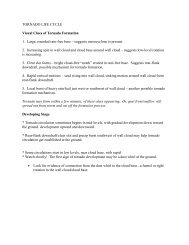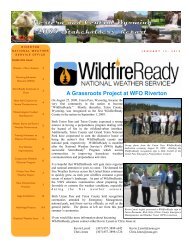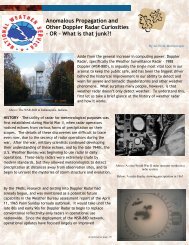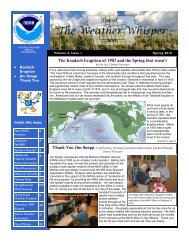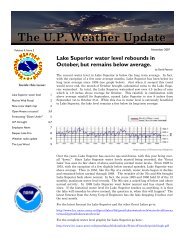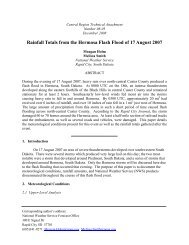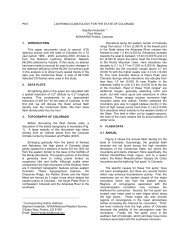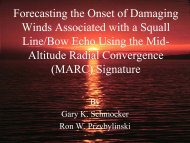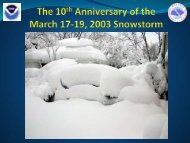Knowledge of Convective Storm Structure, Risk Management, and ...
Knowledge of Convective Storm Structure, Risk Management, and ...
Knowledge of Convective Storm Structure, Risk Management, and ...
Create successful ePaper yourself
Turn your PDF publications into a flip-book with our unique Google optimized e-Paper software.
<strong>Knowledge</strong> <strong>of</strong> <strong>Convective</strong> <strong>Storm</strong><br />
<strong>Structure</strong>, <strong>Risk</strong> <strong>Management</strong>,<br />
<strong>and</strong> Situational Awareness During<br />
Severe Weather Events<br />
By<br />
Ted Funk<br />
SOO, WFO Louisville<br />
April 2003
Severe <strong>Convective</strong> <strong>Storm</strong> <strong>Structure</strong>:<br />
A Quick Review<br />
As warning forecasters, first <strong>and</strong> foremost, we<br />
must thoroughly underst<strong>and</strong> the typical structure<br />
<strong>and</strong> evolution <strong>of</strong> various severe convective storm<br />
types, associated radar signatures, <strong>and</strong> the<br />
implications <strong>of</strong> these signatures.
Classic Supercells
High Precipitation (HP) Supercells<br />
HP supercells exhibit similar features as classic supercells. However, low-levels <strong>of</strong>ten<br />
show a broad high reflectivity pendent or notch (i.e., kidney bean shape) on leading<br />
edge, indicating location <strong>of</strong> rotating updraft. HP mesocyclones may be embedded in<br />
heavy rain. HP storms <strong>of</strong>ten are embedded within squall lines <strong>and</strong> travel along boundaries.<br />
They occur in environments with rich low-level moisture <strong>and</strong> moderate-to-strong<br />
wind shear, <strong>and</strong> may cause tornadoes, large hail, damaging winds, <strong>and</strong> flash floods.
Mini Supercells<br />
Attributes are<br />
similar to classic<br />
supercells, but<br />
dimensions, values,<br />
<strong>and</strong> appearance are<br />
less <strong>and</strong>/or more<br />
subtle, making<br />
detection more<br />
difficult; occur in an<br />
environment with<br />
weak instability but<br />
moderate-to-strong<br />
shear, or where the<br />
tropopause is low<br />
(i.e., under a cold<br />
pool al<strong>of</strong>t)
Key Signatures:<br />
-Bowing line<br />
-Tight reflec gradient<br />
on leading edge<br />
-Weak echo channel<br />
behind line coincident<br />
with rear inflow jet<br />
-Cyclonic vortex just<br />
north <strong>of</strong> apex, where<br />
transient tornadoes<br />
can develop rapidly<br />
Squall Lines/Bow Echoes
Squall Lines/Bow Echoes
Squall Lines/Bow Echoes<br />
Reflectivity contours are solid. Shaded region represents evolution <strong>of</strong> rear inflow jet.<br />
RIJ deflects down to surface near updraft/downdraft interface along leading line.
Mid Altitude Radial Convergence (MARC) in a<br />
Squall Line/Bow Echo<br />
-Strong MARC can occur<br />
along forward flank <strong>of</strong><br />
squall lines before they<br />
begin to bow out<br />
-Persistent areas <strong>of</strong> MARC<br />
(enhanced convergent<br />
velocity differential along a<br />
radial) within larger zone<br />
<strong>of</strong> convergence along forward<br />
flank <strong>of</strong> line appears<br />
to be linked to greatest<br />
degree <strong>of</strong> wind damage<br />
-Persistent MARC usually<br />
located in or just downwind<br />
<strong>of</strong> high reflectivity cores<br />
along leading edge <strong>of</strong> line<br />
-Enhanced areas <strong>of</strong> convergence usually are less than 15 km in length/7 km in width<br />
-A strong velocity gradient between inbound <strong>and</strong> outbound maxima (nearly gate to gate)<br />
yields strongest actual convergence <strong>and</strong> best downburst potential
Mid Altitude Radial Convergence (MARC)<br />
0213z<br />
0213z<br />
0233z<br />
0233z
Mid Altitude Radial Convergence (MARC)<br />
0238z<br />
0238z<br />
0243z<br />
0243z
Mid Altitude Radial Convergence (MARC)<br />
-MARC velocity signature values > 25 m/s<br />
or 50 kt provided avg lead times <strong>of</strong> almost<br />
20 minutes prior to 1st damage report<br />
-MARC <strong>of</strong>ten identified before development<br />
<strong>of</strong> well-defined bow echo<br />
-MARC usually identified at height btwn<br />
4-5 km (12-17 kft) along forward flank <strong>of</strong><br />
line (near high reflectivity cores)<br />
-Can be detected as far as 120 nm from<br />
radar using lowest elevation slice<br />
-MARC has been observed more frequently<br />
with a nearly solid linear convective line<br />
compared to discrete, more isolated cells<br />
-Importance <strong>of</strong> viewing angle: MARC will be underestimated when convective line is not<br />
orthogonal (perpendicular) to radial<br />
-When evaluating MARC <strong>and</strong> subsequent wind damage potential, you must underst<strong>and</strong> environment<br />
it is occurring in. Even with a strong MARC signature, damaging surface winds are less<br />
likely if a deep (greater than or equal to 2 km), cool, stable boundary layer is present (i.e.,<br />
convection is not surface-based but is elevated north <strong>of</strong> a stationary/warm front)
<strong>Risk</strong> <strong>Management</strong><br />
Do you consider RISK in making convective warning decisions?<br />
UNCERTAINTY relates to the likelihood <strong>of</strong> occurrence <strong>of</strong> the event.<br />
RISK is the probability <strong>of</strong> an undesirable event occurring <strong>and</strong> the<br />
significance <strong>of</strong> the consequence <strong>of</strong> the occurrence. So, to underst<strong>and</strong><br />
when a given decision is “risky,” one must have an underst<strong>and</strong>ing <strong>of</strong><br />
potential impacts resulting from the occurrence/nonoccurrence <strong>of</strong> the<br />
event. In essence, decisions are riskier over population centers than in<br />
rural locations since the consequences <strong>of</strong> wrong decisions are greater.<br />
Thus, knowledge <strong>of</strong> convective storm structure <strong>and</strong> radar data<br />
analysis is critical, but may not be enough. We must use 3 data<br />
sets simultaneously to an effort to reduce risk <strong>and</strong> increase the<br />
chance <strong>of</strong> success: radar, environmental data, spotters
<strong>Risk</strong><br />
Potential sources <strong>of</strong> uncertainty or misinterpretation associated with<br />
the following (not a complete listing):<br />
WSR-88D Output<br />
a. Beam width/height vs range e. Data overload in big events<br />
b. Viewing angle (velocity) f. VIL when max refl>60 dBZ<br />
c. Range folding g. Improper de-aliasing<br />
d. Lower res. data vs 8-bit h. SRM vs base velocity<br />
Near-<strong>Storm</strong> Environment Data Sets<br />
a. Inaccurate observations d. Conflicting data<br />
b. Large distance between obs e. Model data w/out observational support<br />
c. Is environment changing as data suggests (or is resolution a problem?)<br />
Spotter Reports<br />
a. Lack <strong>of</strong> spotters d. Which storm is report for?<br />
b. Conflicting reports e. Inaccurate report (are they really seeing<br />
c. Location <strong>of</strong> spotters what they are reporting?)<br />
(are they in position to see<br />
a feature in storm)
<strong>Risk</strong><br />
Radar Data<br />
<strong>Risk</strong> increases with increasing range, decreasing feature size,<br />
range folding<br />
<strong>Risk</strong> decreases with decreasing range, increasing feature size<br />
Environment Data Sets<br />
<strong>Risk</strong> increases with increasing dependency on model data,<br />
decreasing observation coverage, questionable observations<br />
<strong>Risk</strong> decreases with increasing dependency on multiple<br />
observations, increasing observation coverage, reliable obs<br />
Spotter Reports<br />
<strong>Risk</strong> increases with decreased number <strong>of</strong> spotters, decreased<br />
level <strong>of</strong> training (untrained public report), unfavorable spotter<br />
location, unreliable report<br />
<strong>Risk</strong> decreases with increasing number <strong>of</strong> spotters (to confirm<br />
each other’s reports) <strong>and</strong> favorable spotter location
Uncertainty in Radar Data Interpretation<br />
November 11, 2002:<br />
What does radar<br />
data show <strong>and</strong> does<br />
it fit our conceptual<br />
models? Are<br />
we interpreting the<br />
data correctly? Do<br />
we underst<strong>and</strong> what<br />
interactions are<br />
occurring within<br />
the convective line<br />
<strong>and</strong> the effects<br />
these will have on<br />
future convective<br />
evolution?
Uncertainty in Environmental Data<br />
Does the environment<br />
exist/change in time <strong>and</strong><br />
space exactly as our<br />
data sets suggest (or is<br />
the data misleading or<br />
not resolving important<br />
features)?<br />
Are we correctly<br />
interpreting how the<br />
environment is changing<br />
in time <strong>and</strong> space?<br />
Example: Note the CAPE minimum over northeast Alabama on<br />
the LAPS plot (where arrow is pointing). There are no surface<br />
observations here to help confirm the accuracy <strong>of</strong> this<br />
feature. How does this affect our thoughts concerning the<br />
cyclonic circulation near this supposed minimum?
Uncertainty in Spotter Reports<br />
Radar 30nm away shows a supercell with a strong mesocyclone but no spotter<br />
reports have been received.<br />
A spotter then calls in reporting a dark, turbulent sky, but no evidence <strong>of</strong> any<br />
funnel or wall cloud whatsoever.<br />
Do you issue a tornado warning? Was the spotter report accurate? Did you<br />
ask him his location with respect to the storm?<br />
A couple minutes later, you find<br />
out he was positioned north <strong>of</strong><br />
the storm looking south.<br />
A few minutes later, another<br />
spotter calls in south <strong>of</strong> the<br />
storm revealing a rotating wall<br />
cloud <strong>and</strong> tornadogenesis in<br />
progress.<br />
This storm in Kansas produced<br />
a significant tornado.
What do you do when the data disagree?<br />
Radar shows no organized rotation, but a spotter reports a funnel<br />
cloud <strong>and</strong> the storm is approaching a major town or city?<br />
Radar shows a strong mesocyclone al<strong>of</strong>t <strong>and</strong> a spotter reports a<br />
rotating wall cloud, but the storm is in an area with a strong low-level<br />
inversion <strong>and</strong> weak shear?<br />
Radar shows a supercell with moderate rotation in a favorable<br />
environment for tornadoes, but spotters underneath the storm<br />
report no funnels, <strong>and</strong> barely even a wall cloud, <strong>and</strong> the storm is over<br />
a large rural area where few live?<br />
Radar shows a massive supercell with a VIL <strong>of</strong> 80, but velocity data is<br />
masked in range-folding, <strong>and</strong> given that it’s nighttime, there are no<br />
spotters available?
Due to potential risk inherit in all 3 data sets (radar data, environmental data,<br />
spotter reports), the most informed warning decision is born out <strong>of</strong> an<br />
approach that effectively integrates information from all 3 sources, <strong>and</strong><br />
weighs the evidence<br />
This approach includes knowledge <strong>of</strong> data available, knowledge <strong>of</strong> data not<br />
available, knowledge <strong>of</strong> data accuracy/reliability, <strong>and</strong> ability to resolve<br />
conflicting data<br />
Forecaster applies more weight to those data sources <strong>and</strong> types that decrease<br />
risk <strong>and</strong> less weight to those that are associated with increase risk<br />
This also allows us the manage risk, i.e., underst<strong>and</strong> the risk at h<strong>and</strong>, potential<br />
for error <strong>and</strong> resultant consequences; for example, it allows us to issue tornado<br />
warnings when needed but not for every rotating supercell<br />
In effect, this approach allows for better deterministic warnings, <strong>and</strong> less<br />
probabilistic warnings
Situational Awareness in the Warning Environment<br />
-Science<br />
Do we know the environment <strong>and</strong> its relationship to storms; do we<br />
underst<strong>and</strong> storm structure thoroughly in general <strong>and</strong> for the event at<br />
h<strong>and</strong>; are our conceptual models <strong>of</strong> tornadogenesis correct<br />
-Technology<br />
Do we have enough observations/data to help in our assessment <strong>of</strong> the<br />
environment <strong>and</strong> radar data; is the radar, AWIPS, <strong>and</strong> NWR working<br />
efficiently; are TV dissemination systems working correctly<br />
-Human Factors<br />
Are enough people present to h<strong>and</strong>le the event; who’s doing what; are we<br />
applying the science (conceptual models correctly); are we communicating<br />
information well with other staff members; are we using efficient warning<br />
strategies; what personal issues may affect our abilities, concentration, <strong>and</strong><br />
thought processes that day (e.g., fatigue, stress, issues at home,<br />
coworkers, etc.)<br />
-Interactions amongst all three<br />
Is everything <strong>and</strong> everyone working properly <strong>and</strong> together to provide<br />
accurate, timely warning services to the public
Situational Awareness<br />
Definition:<br />
Perception <strong>of</strong> the elements <strong>of</strong> the environment<br />
within a volume <strong>of</strong> space <strong>and</strong> time<br />
Comprehension <strong>of</strong> the meaning <strong>of</strong> these elements<br />
Projection <strong>of</strong> the status <strong>of</strong> the elements in the<br />
near future
Situational Awareness<br />
Perception<br />
Did you use our radar to view<br />
this relatively distant storm?<br />
Is this what your decision was<br />
based on?<br />
Or did you view the low-level<br />
os the same storm from a<br />
closer, neighboring radar?<br />
Did your perception change<br />
based on a different view?
Situational Awareness<br />
Comprehension<br />
Perception<br />
Did you see this?<br />
Now that you’ve seen this, do you<br />
underst<strong>and</strong> what is going on? Why is there<br />
a 65 dBZ core within the hook echo?<br />
Significant debris is concentrated here!
Situational Awareness<br />
Perception<br />
Did you see this?<br />
Comprehension<br />
Do you underst<strong>and</strong><br />
what this is <strong>and</strong> why<br />
there’s a 65 dBZ core<br />
in the hook?<br />
Do you realize what is happening<br />
<strong>and</strong> that a large tornado is on the<br />
ground? How should you project<br />
this information to the public,<br />
<strong>and</strong> what will the tornado do in<br />
the near future?<br />
Tornado Emergency for<br />
Oklahoma City metro area!<br />
Project
Situational Awareness <strong>and</strong> Workload<br />
‣Low SA, Low Workload<br />
Don’t know much, don’t want to know<br />
‣Low SA, High Workload<br />
Don’t know much, but are trying very hard to find out<br />
‣High SA, High Workload<br />
Do know plenty, but at a great effort (too much to do, can’t<br />
keep this pace up for long)<br />
‣High SA, Low Workload<br />
Do know plenty, <strong>and</strong> it comes easily<br />
This is where we want to be…excellent situational awareness <strong>and</strong> a<br />
low workload where the science, equipment, humans, spotters <strong>and</strong><br />
data sources (radar <strong>and</strong> environmental) are working well <strong>and</strong> as a<br />
team to ensure efficient, correct, <strong>and</strong> timely warning services!
We Want to Avoid This !<br />
We didn’t<br />
anticipate this!<br />
The data just<br />
wasn’t very<br />
good.<br />
The equipment<br />
was extremely<br />
unstable.<br />
So – what<br />
problems<br />
did we have<br />
last night?<br />
Problems?<br />
I thought<br />
everything<br />
went well.<br />
Nobody knew<br />
what they were<br />
doing! And our<br />
spotters<br />
weren’t any<br />
help either.<br />
Well, actually<br />
..you were<br />
the biggest<br />
problem.<br />
Who cares –<br />
I’m retiring<br />
next week.




